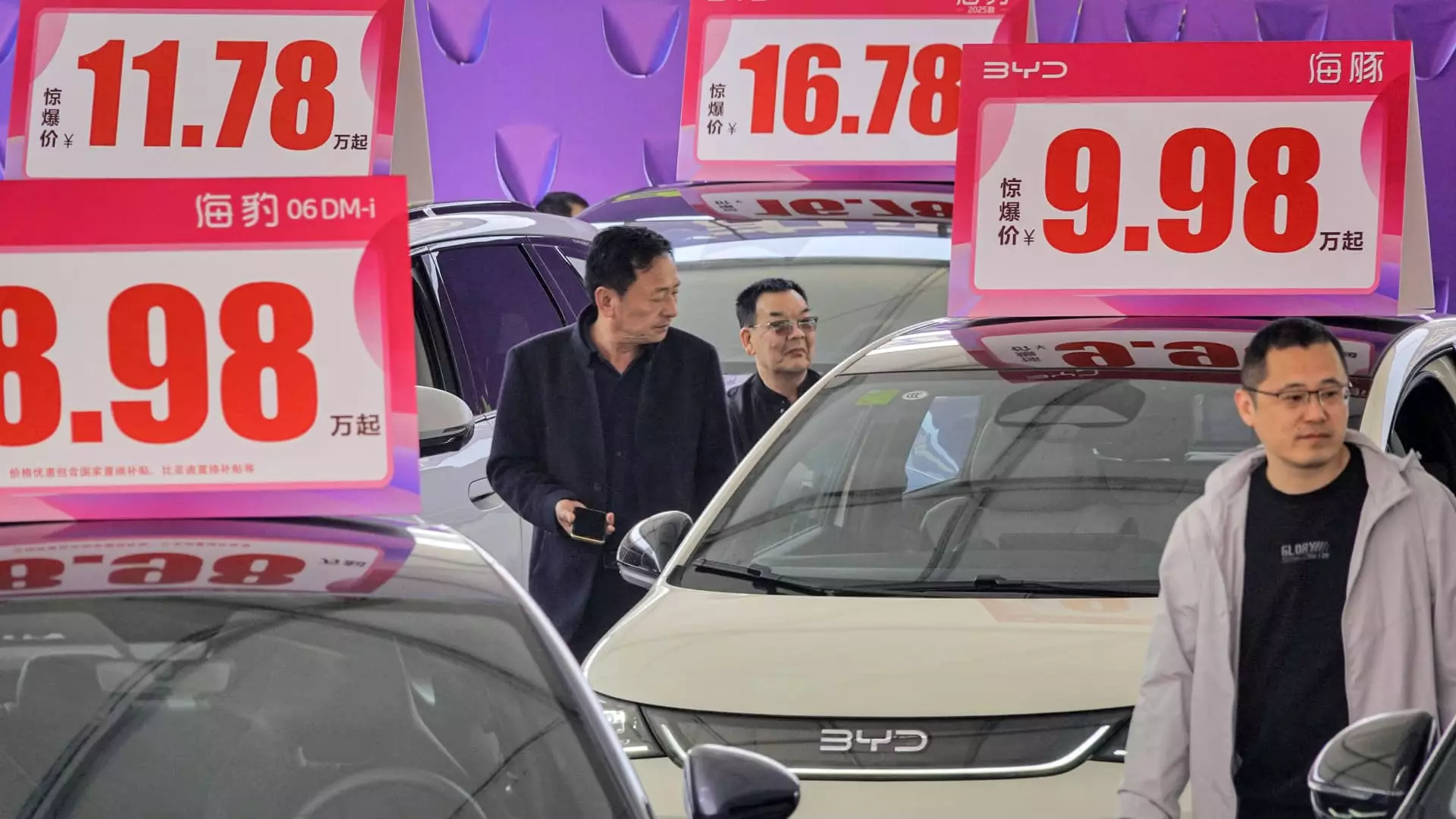China’s electric vehicle (EV) market has entered a tumultuous phase, marked by aggressive pricing strategies that have shaken the foundations of the domestic automotive industry. Recently, BYD, a leading player in the sector, announced drastic price cuts of up to 30% on several of its low-end battery-powered and hybrid offerings. This bold move has not only raised eyebrows but has also triggered a competitive frenzy, prompting other manufacturers to reevaluate their pricing structures. The entry of budget models, such as the Seagull compact car, with prices as low as 55,800 yuan (approximately $7,750), signals a significant shift towards affordability in the EV marketplace.
These developments have left industry analysts, like Zhong Shi from the China Automobile Dealers Association, voicing concerns about the competitive dynamics within the market. As larger companies like BYD adopt aggressive strategies, smaller firms find themselves in a precarious position, scrambling to adapt to an environment where survival increasingly depends on price competitiveness. The daunting reality of stagnant domestic growth places additional pressure on these manufacturers, as they navigate a landscape now dominated by price wars driven by consumer demand for more affordable EV options.
Government Policies and Consumer Behavior
The transformation of China’s automotive sector is intertwined with government subsidies designed to stimulate consumption in a faltering economy. These incentives have fueled expansion in the new energy vehicle market, where electric and hybrid cars have gained traction, comprising nearly half of all new passenger car sales. However, these measures may not be sufficient to combat underlying economic challenges, with prominent economists indicating that a rebound in consumer spending remains unlikely. As Morgan Stanley’s Chief China Economist, Robin Xing, elaborated, the enduring supply-demand imbalance suggests that the road to sustained growth is riddled with obstacles.
Furthermore, the Chinese automotive market faces significant volatility, exacerbated by price cuts that, while appealing to consumers, could lead to greater deflationary pressures within the sector. The average retail price of automobiles has dropped by approximately 19% over the last two years, with steep declines observed in hybrid and battery-only models. In stark contrast, traditional fuel-powered vehicles have experienced minimal reductions, reflecting a shift in consumer preferences that may not benefit all automakers equally.
Controversies and Industry Woes
Amid this backdrop of fierce competition, BYD’s impact on the market cannot be overstated. As one of the most rapidly expanding manufacturers, BYD reported a remarkable 49% increase in net profits. However, the rise in current liabilities by over 60% raises questions about the sustainability of such growth. Observers have drawn parallels between the EV sector and the precarious state of China’s real estate market. Great Wall Motors Chairman Wei Jianjun’s cautions regarding an “Evergrande” scenario in the auto industry highlight the potential pitfalls of unbridled expansion accompanied by excessive debt.
The backdrop of government scrutiny over financial practices within the automotive sector further complicates matters. Reports of companies engaging in dubious practices to secure state subsidies have damaged the integrity of the industry. The Ministry of Finance’s revelations about firms that misappropriated funds serve as a reminder that the road to becoming a global EV leader is fraught with ethical challenges that can undermine consumer confidence and stymie innovation.
The Global Implications of Domestic Strategy
While the intensifying competition primarily affects domestic players, the consequences extend far beyond China’s borders. The European Union’s decision to impose tariffs on Chinese-made electric vehicles and America’s 100% duties indicate a defensive posture against heightened market penetration from Chinese manufacturers. As the global automotive landscape shifts, these protective measures aim to safeguard local industries, adding yet another layer of complexity to the global auto market.
Despite these challenges, Chinese companies persist in their quest for international market share. Recent sales data suggests that BYD has outsold Tesla for the first time in Europe, a reflection of its strategic positioning and aggressive pricing. Such developments underscore the resiliency of Chinese manufacturers even in the face of international pushback, and they raise crucial questions about the future dynamics of the global auto industry, where competition is increasingly shaped by pricing, technological advancements, and geopolitical factors.
Innovations in Consumer-Friendly Features
In an effort to navigate this tumultuous landscape, automakers are also exploring ways to enhance their appeal beyond mere price reductions. The introduction of advanced driver-assist systems at no additional cost, as seen with Geely-backed Zeekr and BYD, represents a strategic shift towards improving the value proposition of vehicles. By emphasizing technological features rather than solely competing on price, companies can forge deeper connections with consumers and foster brand loyalty.
This pivot towards technology reflects a broader trend where consumer demands are not just about affordability but also about the perceived value derived from additional features. It is a testament to the evolving nature of consumer preferences within the auto industry, where the interplay of pricing and technological innovation can determine market leadership in the years to come. As the competition heats up, it is clear that success will hinge on a multifaceted approach that balances affordability with quality and innovation.

